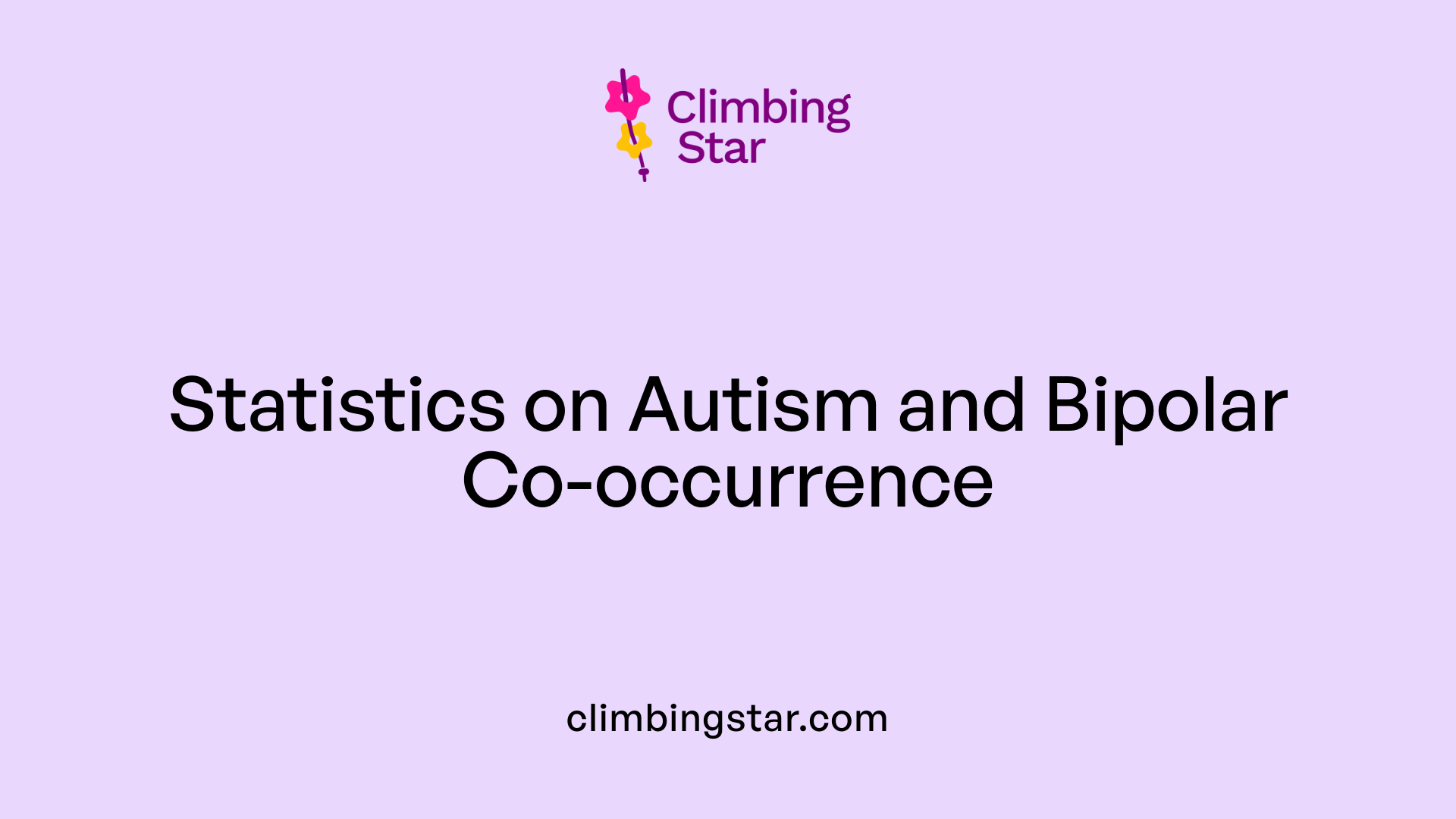Understanding the Overlap of Autism and Mood Disorders
Autism spectrum disorder (ASD) and bipolar disorder are distinct neurodevelopmental and mood conditions that can co-exist, complicating diagnosis and treatment. This article explores their symptoms, prevalence, challenges in diagnosis, underlying links, and management strategies to better inform clinicians, patients, and families.
Symptoms and Clinical Features of Autism and Bipolar Disorder

What are the symptoms and clinical features of autism and bipolar disorder?
Autism spectrum disorder (ASD) primarily manifests through difficulties in social communication, including challenges in social interaction, understanding social cues, and forming relationships. It also features repetitive behaviors, strong sensory sensitivities, and learning challenges, making daily functioning difficult for many individuals.
Bipolar disorder, on the other hand, is characterized by dramatic mood swings that alternate between episodes of mania and depression. Manic episodes include heightened energy levels, decreased need for sleep, impulsivity, grandiosity, and sometimes agitation or irritability. Conversely, depressive phases involve feelings of sadness, fatigue, loss of interest, and social withdrawal.
When both autism and bipolar disorder occur together, their symptoms can overlap, complicating diagnosis. Common overlapping issues include irritability, sleep disturbances, and behavioral fluctuations.
In autistic individuals, bipolar symptoms often appear as rapid speech, incessant pacing, impulsivity, and sudden mood shifts. These manifestations can disrupt daily life and social relationships, emphasizing the importance of careful, ongoing assessment.
Effective management requires distinguishing between core autism traits and bipolar symptoms to tailor appropriate treatment strategies, such as medication and supportive therapies.
The Relationship Between Autism and Bipolar Disorder: Genetic and Neurobiological Insights

What is the relationship between autism and bipolar disorder?
Autism spectrum disorder (ASD) and bipolar disorder are distinct conditions, with autism generally classified as a neurodevelopmental disorder affecting social communication and behavior, while bipolar disorder involves mood swings between depression and mania. However, these conditions often co-occur, especially in individuals with autism. Studies estimate that about 5% to 8% of autistic individuals also have bipolar disorder, highlighting a notable overlap.
Research into their connection reveals shared genetic and neurobiological factors. Certain gene expression patterns involved in brain development and synaptic functioning are common to both conditions. These shared genetic markers point toward a biological link that might predispose some individuals to both disorders.
Neurobiologically, both autism and bipolar disorder involve irregularities in brain circuitry affecting mood regulation, social functioning, and neuroplasticity. Variations in brain chemistry and development may create a vulnerability that manifests as either or both conditions, depending on developmental timing, environmental influences, and genetic predispositions.
Autism typically presents early, during childhood, with signs such as social challenges and repetitive behaviors. Conversely, bipolar disorder often emerges in adolescence or early adulthood, with rapid mood shifts, impulsivity, and energy fluctuations becoming prominent. Recognizing these distinct developmental patterns helps clinicians diagnose and differentiate the conditions accurately.
In summary, the link between autism and bipolar disorder involves complex genetic and neurobiological intersections. While they are separate diagnoses, overlapping biological vulnerabilities are evident, making ongoing research into shared mechanisms crucial for early detection and targeted treatments.
For further understanding, searching "Genetic and neurobiological links between autism and bipolar disorder" provides detailed insights into this evolving field.
Prevalence and Co-occurrence: How Common Are These Conditions Together?

How common is the co-occurrence of autism and bipolar disorder?
The co-occurrence of autism spectrum disorder (ASD) and bipolar disorder is relatively rare but holds significant clinical importance. Studies suggest that about 5% to 8% of individuals with ASD also meet diagnostic criteria for bipolar disorder. This crossover is higher than the roughly 4% prevalence seen in the general population.
In terms of age groups, bipolar disorder affects approximately 1% to 2% of youth with autism, while in adults, the prevalence rises to around 7.5%. Notably, about 10% of autistic adults are affected by bipolar disorder, highlighting a noteworthy overlap in this population.
Despite its relative rarity compared to other comorbidities such as anxiety or ADHD—where comorbidity rates can reach up to 81%—the dual diagnosis demands careful consideration. The overlap of symptoms, such as mood swings, irritability, and impulsivity, can obscure diagnosis and complicate treatment planning.
The higher prevalence of bipolar disorder among those with autism likely stems from shared genetic vulnerabilities and neurodevelopmental pathways. Both conditions may involve overlapping disruptions in brain chemistry and neurocircuitry, contributing to their co-occurrence.
Identifying bipolar disorder in individuals with ASD is crucial because it affects treatment choices and prognosis. Proper diagnosis ensures that effective mood stabilizers and psychological therapies can be appropriately used, improving long-term outcomes.
| Population Group | Estimated Prevalence (%) | Notes |
|---|---|---|
| General population | 4% | Baseline for bipolar disorder |
| Autistic youth | 1-2% | Higher risk than general population |
| Autistic adults | About 7.5% | Increased prevalence |
| Autistic adults | Nearly 10% | A significant subgroup |
Understanding the prevalence of dual diagnoses helps clinicians recognize the need for targeted screening and personalized intervention strategies, ultimately supporting better management of these complex cases.
Challenges in Diagnosing Autism and Bipolar Disorder Simultaneously

What are the challenges in diagnosing autism and bipolar disorder simultaneously?
Diagnosing both autism spectrum disorder (ASD) and bipolar disorder (BD) at the same time can be quite complicated. This difficulty mainly stems from overlapping symptoms that are common to both conditions. For example, individuals may display irritability, sleep issues, impulsivity, behavioral changes, and sensory sensitivities. These shared signs can make it hard to distinguish where one condition ends and the other begins.
A significant issue in diagnosis is what's known as diagnostic overshadowing. This occurs when symptoms of one disorder are mistaken for or hide symptoms of another. For instance, a person with autism might be seen as simply having difficulty with emotional regulation, ignoring potential bipolar features like mood swings or episodes of mania and depression.
In some autistic individuals, especially those who are high-functioning or undiagnosed until adulthood, bipolar episodes may present atypically. Instead of classic mania or depression, symptoms might manifest as persistent irritability or stereotyped behaviors, which can be mistaken for autism traits.
To accurately diagnose these co-occurring conditions, healthcare professionals rely on thorough, longitudinal assessments that observe symptom patterns over time. This involves detailed interviews, assessments of mood episodes, and family history analysis.
Using specialized assessment tools combined with keen clinical judgment helps differentiate between autism behaviors and mood episodes. It's crucial to evaluate the onset age of symptoms, the duration, and triggers of mood changes.
Overall, careful, ongoing observation and expert evaluation are essential. Only through detailed and comprehensive assessment can clinicians confidently identify and treat both conditions effectively.
Management Strategies and Treatment Options for Dual Diagnosis
What treatment options are available for individuals with both autism and bipolar disorder?
Managing co-occurring autism and bipolar disorder requires a comprehensive approach that combines medication, therapy, and support strategies tailored to the individual's unique needs. Pharmacological treatments typically include mood stabilizers such as valproic acid and lithium. These medications help regulate mood swings but demand close monitoring due to potential side effects, especially in individuals with communication and developmental challenges.
In addition to mood stabilizers, atypical antipsychotics like risperidone and aripiprazole are commonly prescribed. These drugs are particularly effective in managing irritability, aggression, and mood fluctuations associated with bipolar disorder in autistic individuals. It's important to observe for adverse effects, including weight gain, sedation, or metabolic changes.
Psychological therapies adapted for autism, such as cognitive-behavioral therapy (CBT), are vital. They help individuals recognize early signs of mood episodes, develop coping skills, and improve emotional regulation. Family involvement through psychoeducation and support groups can enhance understanding and adherence to treatment plans.
Emerging treatments, like ketamine infusions, are under evaluation for rapid mood stabilization but require further research to verify safety and effectiveness in persons with autism.
Support strategies are equally important. Implementing routines, using mood diaries, engaging in calming activities, and building supportive networks can help individuals maintain stability. Managing a complex dual diagnosis demands coordination among psychiatrists, psychologists, family members, and caregivers to optimize outcomes.
| Treatment Component | Medication Examples | Focus Area | Monitoring Considerations |
|---|---|---|---|
| Mood Stabilizers | Valproic acid, Lithium | Mood regulation, preventing mood swings | Liver function, blood levels, kidney health |
| Antipsychotics | Risperidone, Aripiprazole | Irritability, aggression, mood stabilization | Weight, metabolic panel, sedation effects |
| Psychological Therapies | CBT adapted for autism | Emotional regulation and coping skills | Therapy adherence, progress tracking |
| Support Strategies | Routines, diaries, activities | Mood stability and stress reduction | Consistency, caregiver involvement |
This multifaceted treatment approach aims to enhance quality of life, reduce episodes of mood instability, and support social and emotional development in individuals facing the dual challenge of autism and bipolar disorder.
Developmental and Long-term Course of Autism and Bipolar Disorder
How does having both autism and bipolar disorder affect an individual's developmental and long-term course?
The coexistence of autism spectrum disorder (ASD) and bipolar disorder can profoundly impact an individual’s development and lifespan. Each condition brings unique challenges, and when combined, they often lead to more complex clinical presentations.
Autistic individuals with bipolar disorder tend to experience an earlier onset of mood symptoms, often in childhood or adolescence. This early emergence can complicate developmental progress, particularly in social and adaptive skills. The presence of mood swings, manic episodes, or depression may interfere with learning, social interactions, and daily functioning.
Research indicates that youth with both conditions tend to show more mixed symptoms, such as irritability, distractibility, and social withdrawal, which can hinder social relationships and academic success. These symptoms might be mistaken for autism or ADHD, delaying accurate diagnosis and appropriate treatment.
Long-term, this dual diagnosis often results in greater functional impairments. Individuals may face challenges in establishing independence, maintaining relationships, or holding employment. They are also at increased risk for psychiatric comorbidities like anxiety, OCD, and depression, which can further complicate outcomes.
However, early diagnosis and comprehensive, individualized intervention can significantly improve the prognosis. Treatment typically involves mood stabilizers, antipsychotics, and therapies like cognitive-behavioral therapy, adjusted for the needs of autistic individuals.
Support strategies such as routine management, social skills training, and family education are vital in helping individuals manage symptoms, foster resilience, and enhance quality of life.
In summary, the combined presence of autism and bipolar disorder necessitates a multidisciplinary approach to mitigate developmental delays, support mental health stability, and promote long-term well-being. Tailored interventions can help affected individuals navigate their developmental trajectory more successfully, enabling them to reach their full potential.
Resources, Support, and Expert Insights on Autism and Bipolar Disorder
For individuals seeking in-depth information on autism and bipolar disorder, reputable organizations such as the American Academy of Child and Adolescent Psychiatry (AACAP) offer valuable resources including clinical guidelines, research papers, and educational materials. These organizations provide insights into diagnostic challenges, treatment strategies, and ongoing research efforts.
Support for families and patients is accessible through autism resource centers, mental health organizations, and specialized research institutes. Many of these platforms offer guidance on managing symptoms, understanding comorbid conditions, and connecting with support networks.
Educational and professional resources are also available via scientific journals and research publications that explore the complexities of co-occurring autism and bipolar disorder. These sources help clinicians and families stay informed about new findings, innovative therapies, and best practices.
Expert opinions are often shared through dedicated websites and conferences focused on autism and mood disorders. Many organizations feature expert-led webinars, articles, and toolkits that can assist in early recognition, accurate diagnosis, and personalized treatment planning.
In summary, extensive knowledge about autism and bipolar disorder can be obtained from credible organizations, research outlets, and support services that aim to improve understanding, diagnosis, and management of these interconnected conditions.
Looking Ahead: Improving Outcomes for Dual Diagnoses
Understanding and managing the co-occurrence of autism and bipolar disorder is vital for enhancing quality of life. Continued research into their genetic, neurobiological, and environmental links will advance diagnosis and personalized treatment. With early intervention, tailored therapies, and robust support systems, individuals facing these dual diagnoses can achieve better developmental, emotional, and social outcomes. Collaboration among clinicians, researchers, families, and support organizations is essential to realize these goals and foster resilience amid lifelong challenges.
References
- Autism and Bipolar disorder
- Bipolar disorder
- Autism and the Risk of Bipolar Disorder
- Longitudinal Course of Bipolar Disorder in Youth With High ...
- Occurrence of psychosis and bipolar disorder in adults with ...
- Navigating the intersection between autism spectrum ...
- Understanding Autism and Bipolar Disorder
- Subthreshold autism spectrum in bipolar disorder







